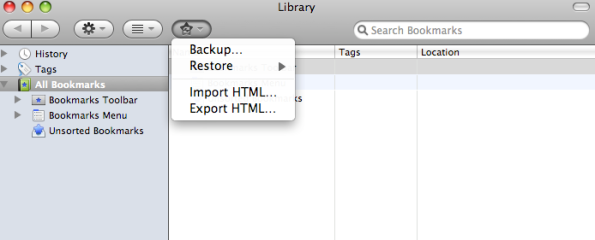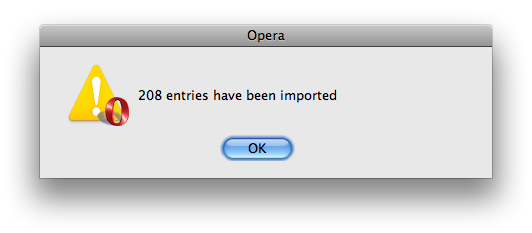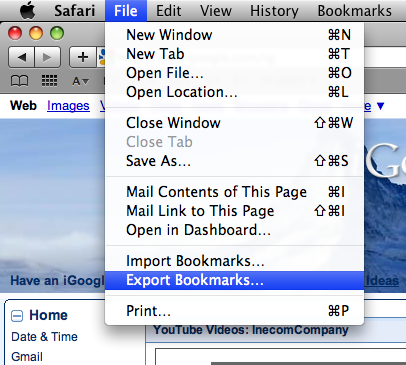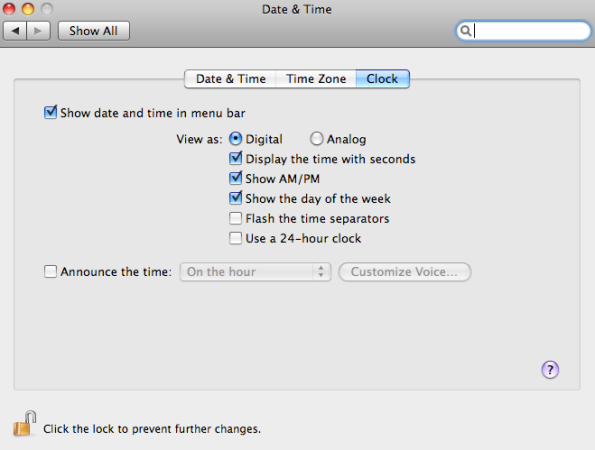Archive
Tip 18: Multiple Home Pages With Google Chrome
![]() New Google Chrome OS X users – here’s a quick tip on how to set multiple homepages with Chrome. When you open Google Chrome, the homepage will be the first website to open on the browser at startup. Here’s how you do it.
New Google Chrome OS X users – here’s a quick tip on how to set multiple homepages with Chrome. When you open Google Chrome, the homepage will be the first website to open on the browser at startup. Here’s how you do it.
1. Open Google Chrome
2. Go Chrome > Preferences (Or Command-,)

3. On the Basics tab in Preferences, select the option Open The following pages
4. There are two ways you can select your homepage. You can either previously load the websites you want and then click Use Current. You can also type in the URL or URLs you want for your homepage.
And that’s it. Your new homepages will be set.
– Alexander Garovi
Tip 17: Changing The Dock Theme
LeopardDocks is simple application that changes the Dock Theme. Its straightforward UI makes it very easy to modify your Dock and undo changes. I highly recommend LeopardDocks to anyone who wants to give their dock a little personality.

Dock Themes
On the LeopardDocks website, there is a collection of various Dock themes that can be downloaded.
To Change The Theme
1. Download and Launch LeopardDocks. Download a theme from leoparddocks.com
2. In LeopardDocks, browse for the downloaded theme

3. Select the theme, click “Change My Dock” and confirm the changes with your password.
The Dock theme will now change
– Alexander Garovi
Tip 16: Hide Desktop Clutter
 Want to give your Desktop a new clean look? With Terminal, you can forget about organizing all of your Desktop files and simply hide them. Enter this command in Terminal:
Want to give your Desktop a new clean look? With Terminal, you can forget about organizing all of your Desktop files and simply hide them. Enter this command in Terminal:
chflags hidden ~/Desktop/*
To Undo:
chflags nohidden ~/Desktop/*
This command is very useful, if you don’t want to deal with constantly having Desktop clutter.
– Alexander Garovi
Tip 15: Quick Software Update With Terminal
 Here’s a quick Terminal command that lets you install Apple’s available software updates. There are two sudo commands: one for installing all of Apple’s updates and one for only installing recommended software updates.
Here’s a quick Terminal command that lets you install Apple’s available software updates. There are two sudo commands: one for installing all of Apple’s updates and one for only installing recommended software updates.
All Updates
sudo softwareupdate -i -a
Recommended Updates
sudo softwareupdate -i -r
More quick Terminal tips are on the way.
– Alexander Garovi
Tip 14: More Frequent Auto Saves In Microsoft Word
 Here’s another Microsoft Word Tip. Saving your work is always important, in order to prevent frustrating data loss. Luckily, if you sometimes forget to save, Word auto saves your progress at a default setting of every 10 minutes. You can even shorten this amount of time and make auto saves more frequent. Here’s how you do it:
Here’s another Microsoft Word Tip. Saving your work is always important, in order to prevent frustrating data loss. Luckily, if you sometimes forget to save, Word auto saves your progress at a default setting of every 10 minutes. You can even shorten this amount of time and make auto saves more frequent. Here’s how you do it:
1. Open Microsoft Word
2. With a document open, go File > System Preferences (Command-,)
3. In the Output and Sharing section, select Save
4. You will see a checkbox next to “Save AutoRecover info every (set amount of time) minutes”
![]()
5. Enter the amount of time between auto saves
Note: I believe you have to save one time manually, before the auto save function works.
This tip concludes today’s Microsoft Word tips.
– Alexander Garovi
Tip 13: Changing The Default Font In Microsoft Word
 If you want to give your docs a new look, changing the default font is very easy to do. Here’s how you do it:
If you want to give your docs a new look, changing the default font is very easy to do. Here’s how you do it:
1. Open Microsoft Word
2. Open a document, or create a New Blank Document
3. Go Format > Font (Command-D)
4. Select the font, size, font styles etc.
5. On the bottom-left hand corner of the window, click Default
6. A box asking if you want to change the default font will appear. Click Yes

Your default font will now be the selected one. More quick Microsoft Word tips are on the way.
– Alexander Garovi
Tip 12: Renaming Bootcamp Partitions
Tired of seeing the name, “untitled” under your Bootcamp partition? With a few easy steps, you can change it to something more interesting. Before changing the partition’s name, you must reboot into Windows. Unable to take screenshots in Windows, I was forced to use my camera :-/. Here’s how you do it:
1. Reboot into Windows
2. Go Start > My Computer
3. You will see the C: named “UNTITLED”.

4. Highlight the HD’s name, enter a new name and press Enter

5. Reboot in OS X and you should see your partition with its new name. The only issue with this tweak is that the new name will be in caps.
Before:

After:

I personally don’t use a name at all – At startup in OS X, highlight the partition’s name and press Spacebar and Enter. This must be done in OS X, because Windows doesn’t permit empty Disk names. At the computer’s next startup, the name will be changed back to “Untitled”.

– Alexander Garovi
Tip 10: Quick Picture Converting With Preview

Have a picture that you want to convert into a different format? With a couple clicks you can convert a picture to your desired type with OS X’s Preview. Here’s how you do it:
1. Open the picture in Preview
2. Go File > Save As
3. From here, there are numerous photo formats you can save your picture as

Using Preview as an image converter is a lighter alternative to using Photoshop any other large photo editing programs to change a photo type. Sometimes photo conversion is especially necessary when uploading pictures to some websites that only take certain photo formats.
– Alexander Garovi
Tip 09: Transferring Bookmarks With Firefox, Opera & Safari
If you want to change internet browsers, you don’t have to re-bookmark your favorite websites. Transferring bookmarks between Firefox, Opera and Safari is very easy to do. Here’s how you do it:
Firefox –
To export bookmarks
1. Open FireFox
2. On the menu bar go Bookmarks > Organize Bookmarks
3. On the bar at the top of the window, click on the button with the star
4. Select Export HTML and select where you want to save the file

To import bookmarks
1. Go Bookmarks > Organize Bookmarks
2. Select the star button in the bookmarks window toolbar and select Export HTML
Opera
To export bookmarks
1. Go Bookmarks > Manage Bookmarks
3. Click on File (The floppy disc icon)
4. Click on Export As HTML

To import bookmarks
1. In Opera, go File > Import and Export > Import Netscape/Firefox Bookmarks
2. Now locate and select your bookmarks.html file

Safari
To export bookmarks
1. Go File > Export Bookmarks

To import bookmarks
1. Go File > Import Bookmarks
– Alexander Garovi
Tip 08: Customizing The Menu bar Clock
As you might already know, the Mac clock is usually located at the top right corner of the menu bar, next to whatever other menu bar applications you have. This clock can be customized, or even removed if so desired. Here’s how to do it:
1. Open System Preferences and select Date & Time. You can also click on the menu bar clock and select Date & Time from there.
2. Select the Clock tab
3. From here you can modify any of the existing settings to manipulate the clock. To remove the clock, uncheck the Show the date and time box.

You can select between a digital or analog clock, with the choice of the AM/PM shown, seconds, day of the week, flashing time separators and a 24-hour clock.
– Alexander Garovi
